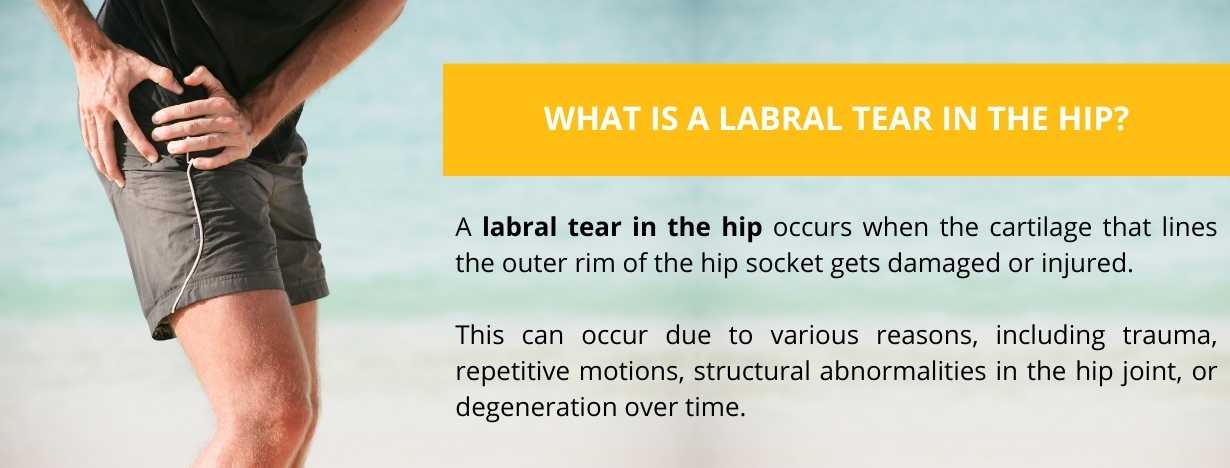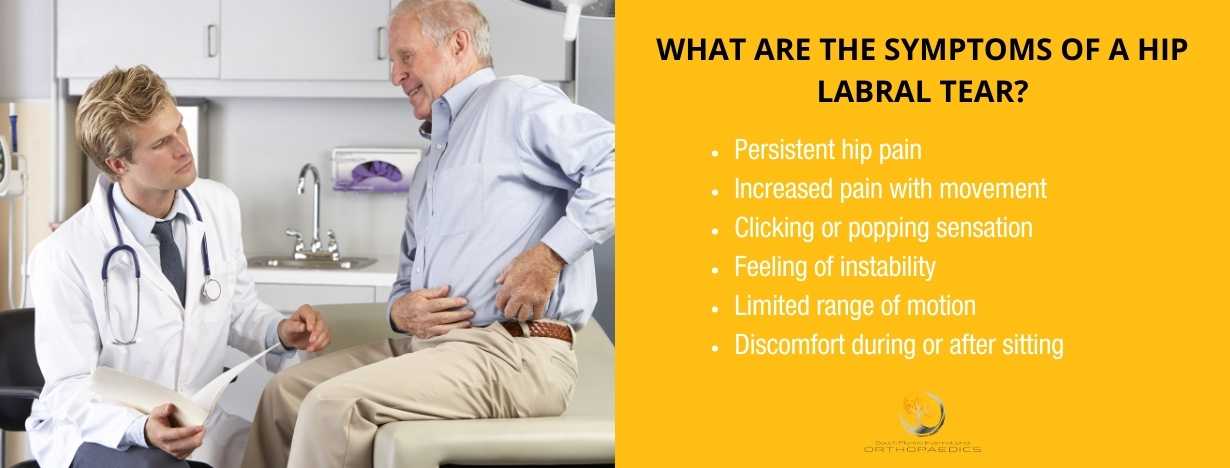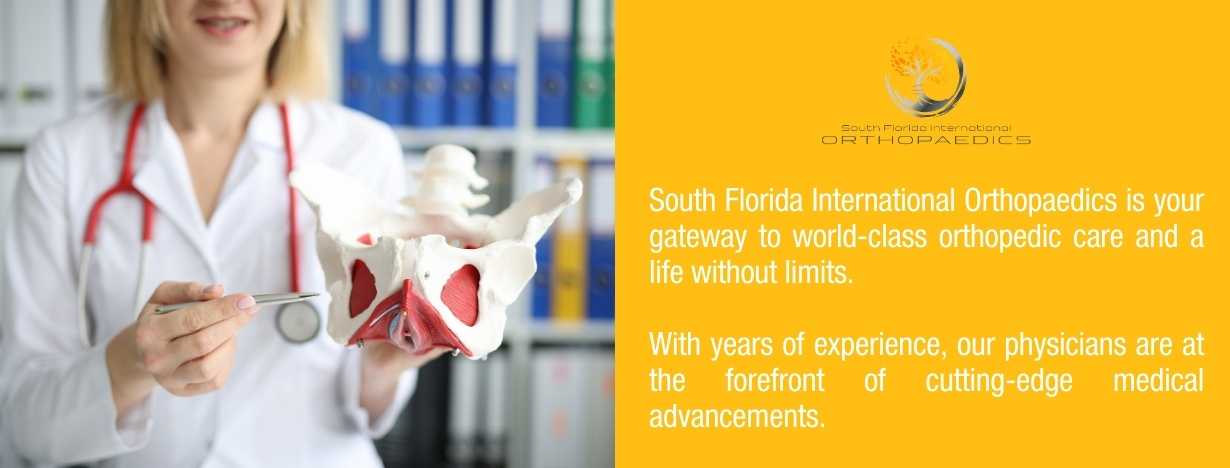If you’ve ever experienced persistent hip discomfort or pain, you might be wondering if it could be attributed to a labral tear. Understanding the symptoms associated with a labral tear in the hip is crucial for timely diagnosis and appropriate management.
In this comprehensive guide, we’ll explore the nuances of a labral tear, from its origins to the distinct sensations it produces.
What is a labral tear in the hip?
The hip labrum is a ring of cartilage that lines the outer rim of the hip socket, providing stability and cushioning. Imagine it as a protective seal, ensuring smooth movement within the hip joint.

A labral tear in the hip occurs when this ring of cartilage gets damaged or injured, causing a range of symptoms and discomfort. These damages can occur due to various reasons, including trauma, repetitive motions, structural abnormalities in the hip joint, or degeneration over time.
Athletes, particularly those involved in sports with frequent hip movements like soccer, football, or hockey, may be more susceptible to hip labral tears.
What are the common causes of labral tears?
A variety of factors can cause labral tears in the hip, and they often result from a combination of issues. Here are some common causes of labral tears:
1. Trauma or injury
Direct trauma to the hip, such as a fall or a forceful impact, can cause the labrum to tear. This is often seen in accidents or sports-related injuries.
2. Repetitive movements
Activities that involve repetitive hip movements or frequent pivoting, such as those in certain sports (e.g., soccer, hockey, or ballet), can contribute to overuse and wear on the hip joint, increasing the risk of a labral tear over time.
3. Structural abnormalities
Anatomical variations or structural abnormalities in the hip joint can predispose individuals to labral tears. Conditions like hip dysplasia, where the hip socket is too shallow, or femoroacetabular impingement (FAI), where there is abnormal contact between the ball and socket of the hip joint, can contribute to labral damage.
4. Aging and degeneration
As individuals age, the hip labrum can undergo natural wear and tear, leading to degeneration. Over time, this can weaken the labrum and make it more susceptible to tearing.
5. Hip joint instability
Conditions that cause instability in the hip joint, such as ligament laxity or muscle imbalances, may contribute to increased stress on the labrum, making it more prone to tears.
6. Genetic factors
There may be a genetic predisposition to developing labral tears. Some individuals may have a family history of hip issues or joint problems that increase their likelihood of experiencing a labral tear.
What are the telltale signs of a hip labral tear?
A hip labral tear can manifest with various signs and symptoms, and the experience can differ among individuals. Here are the symptoms commonly associated with a hip labral tear:
Persistent hip pain
One of the primary symptoms is a deep, aching pain in the hip joint. This pain may be present in the front of the hip or deep within the groin and can be intermittent or constant.
Increased pain with movement
Pain often intensifies during specific movements or activities that involve flexing or rotating the hip. Common triggers include walking, running, climbing stairs, or sitting for extended periods.

Clicking or popping sensation
Some individuals with a labral tear report a clicking, popping, or catching sensation in the hip joint. This may occur during certain movements and can be a distinctive feature associated with labral tears.
Feeling of instability
A sense of instability or a feeling that the hip may give way can be indicative of a labral tear. This sensation may affect balance and stability during weight-bearing activities.
Limited range of motion
A labral tear can lead to a reduced range of motion in the hip. Patients may find it challenging to perform activities that require a wide range of hip movements, such as squatting or bending.
Discomfort during or after sitting
Prolonged sitting and other activities that flex the hip can exacerbate pain and discomfort associated with a labral tear. Getting up from a seated position may trigger pain or stiffness.
How is it diagnosed?
It’s important to note that the symptoms of a hip labral tear can overlap with those of other hip conditions, such as arthritis or muscle strains.
Additionally, some individuals with labral tears may be asymptomatic or experience only mild discomfort. Because of this variability, seeking a professional medical evaluation is crucial for an accurate diagnosis and appropriate management.
An orthopedic specialist may use a combination of physical examinations, imaging studies such as MRI or arthroscopy, and a detailed medical history to confirm a labral tear diagnosis.
Each step in this process contributes to a comprehensive understanding of the extent of the injury, guiding the subsequent treatment plan.
What are the treatment options for a hip labral tear?
The treatment of a hip labral tear depends on various factors, including the severity of the tear, the patient’s age, and overall health. Conservative approaches, such as physical therapy and pain management, are often employed initially.

In cases where conservative measures fail to provide relief or for more severe tears, surgical options may be recommended. Surgical procedures may include arthroscopic surgery or labral reconstruction.
Why choose South Florida International Orthopaedics?
Are you living with the discomfort of a labral tear or any other orthopedic condition? Don’t lose hope—South Florida Orthopaedics is your gateway to world-class orthopedic care and a life without limits.
Our team of orthopedic specialists boasts unparalleled expertise in diagnosing and treating labral tears and a wide range of orthopedic conditions. With years of experience, our physicians are at the forefront of cutting-edge medical advancements. Some of the services we provide include:
- Hip arthroscopy Miami
- Hip labral tear treatment Miami
- Shoulder care
- Joint replacements
- Arthritis care
- Physical therapy
- Sports medicine Miami
Contact us now at (305) 233-0011 to schedule your consultation!
The material contained on this site is for informational purposes only and DOES NOT CONSTITUTE THE PROVIDING OF MEDICAL ADVICE, and is not intended to be a substitute for independent professional medical judgment, advice, diagnosis, or treatment. Always seek the advice of your physician or other qualified healthcare providers with any questions or concerns you may have regarding your health.
